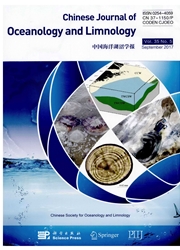

 中文摘要:
中文摘要:
Phaeocystis globosa 的花蕾经常在中国沿海的水里被报导了,引起海洋的生态系统的严重损坏。更好理解 P 的生态的特征。在 P 的生长上便于它的快速的扩大,温度的效果,咸度和发光的中国沿海的水里的 globosa。来自华南海的 globosa 在实验室被检验。为 P 的生长的浸透的发光。globosa (我 s ) 是 60 mol/(m 2 s ) ,它是比另外的有害海藻的种类的那些低的(70-114 mol/(m 2 s )) 。0.22/d 的中等生长率在 2 mol/ 被观察(m 2 s )( 在实验的最小的发光) ,并且相片抑制没发生在 230 mol/(m 2 s )( 在实验的最大的发光) 。暴露了到温度的 42 不同联合(10-31 映牯映瑵牵 ? 瑳摵敩 ? 删 ?? 敷敲攠瑳浩瑡摥琠? 敢 ? ┲ ?? ㈱?? ┴ ???? 湡 ?? ‥㈨ ?? 映牯漠敮栠癩? 数 ? 楴敭瀠楯瑮 ? 楮敮琠瑯污栠癩獥)
 英文摘要:
英文摘要:
Blooms of Phaeocystis globosa have been frequently reported in Chinese coastal waters, causing serious damage to marine ecosystems. To better understand the ecological characteristics of P. globosa in Chinese coastal waters that facilitate its rapid expansion, the effects of temperature, salinity and irradiance on the growth of P. globosa from the South China Sea were examined in the laboratory. The saturating irradiance for the growth ofP. globosa (Is) was 60 μmol/(m^2·s), which was lower than those of other harmful algal species (70-114μmol/(m^2·s)). A moderate growth rate of 0.22/d was observed at 2 μmol/(m^2·s) (the minimum irradiance in the experiment), and photo-inhibition did not occur at 230 μmol/(m^2·s) (the maximum irradiance in the experiment). Exposed to 42 different combinations of temperatures (10- 31 ℃) and salinities (10-40) under saturating irradiance, P. globosa exhibited its maximum specific growth rate of 0.80/d at the combinations of 24℃ and 35, and 27℃ and 40. The optimum growth rates (〉0.80/d) were observed at temperatures ranging from 24 to 27℃ and salinities from 35 to 40. While P. globosa was able to grow well at temperatures from 20℃ to 31℃ and salinities from 20 to 40, it could not grow at temperatures lower than 15℃ or salinities lower than 15. Factorial analysis revealed that temperature and salinity has similar influences on the growth of this species. This strain ofP. globosa not only prefers higher temperatures and higher salinity, but also possesses a flexible nutrient competing strategy, adapted to lower irradiance. Therefore, the P. globosa population from South China Sea should belong to a new ecotype. There is also a potentially high risk of blooms developing in this area throughout the year.
 同期刊论文项目
同期刊论文项目
 同项目期刊论文
同项目期刊论文
 期刊信息
期刊信息
